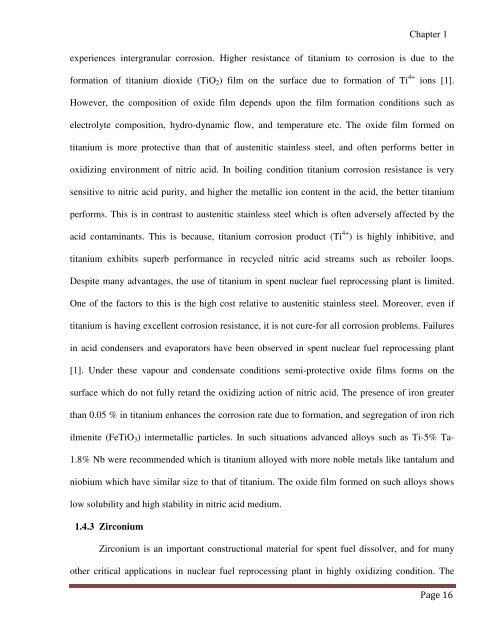CHEM02200704003 Nilamadhab Pandhy - Homi Bhabha National ...
CHEM02200704003 Nilamadhab Pandhy - Homi Bhabha National ...
CHEM02200704003 Nilamadhab Pandhy - Homi Bhabha National ...
Create successful ePaper yourself
Turn your PDF publications into a flip-book with our unique Google optimized e-Paper software.
Chapter 1<br />
experiences intergranular corrosion. Higher resistance of titanium to corrosion is due to the<br />
formation of titanium dioxide (TiO 2 ) film on the surface due to formation of Ti 4+ ions [1].<br />
However, the composition of oxide film depends upon the film formation conditions such as<br />
electrolyte composition, hydro-dynamic flow, and temperature etc. The oxide film formed on<br />
titanium is more protective than that of austenitic stainless steel, and often performs better in<br />
oxidizing environment of nitric acid. In boiling condition titanium corrosion resistance is very<br />
sensitive to nitric acid purity, and higher the metallic ion content in the acid, the better titanium<br />
performs. This is in contrast to austenitic stainless steel which is often adversely affected by the<br />
acid contaminants. This is because, titanium corrosion product (Ti 4+ ) is highly inhibitive, and<br />
titanium exhibits superb performance in recycled nitric acid streams such as reboiler loops.<br />
Despite many advantages, the use of titanium in spent nuclear fuel reprocessing plant is limited.<br />
One of the factors to this is the high cost relative to austenitic stainless steel. Moreover, even if<br />
titanium is having excellent corrosion resistance, it is not cure-for all corrosion problems. Failures<br />
in acid condensers and evaporators have been observed in spent nuclear fuel reprocessing plant<br />
[1]. Under these vapour and condensate conditions semi-protective oxide films forms on the<br />
surface which do not fully retard the oxidizing action of nitric acid. The presence of iron greater<br />
than 0.05 % in titanium enhances the corrosion rate due to formation, and segregation of iron rich<br />
ilmenite (FeTiO 3 ) intermetallic particles. In such situations advanced alloys such as Ti-5% Ta-<br />
1.8% Nb were recommended which is titanium alloyed with more noble metals like tantalum and<br />
niobium which have similar size to that of titanium. The oxide film formed on such alloys shows<br />
low solubility and high stability in nitric acid medium.<br />
1.4.3 Zirconium<br />
Zirconium is an important constructional material for spent fuel dissolver, and for many<br />
other critical applications in nuclear fuel reprocessing plant in highly oxidizing condition. The
















